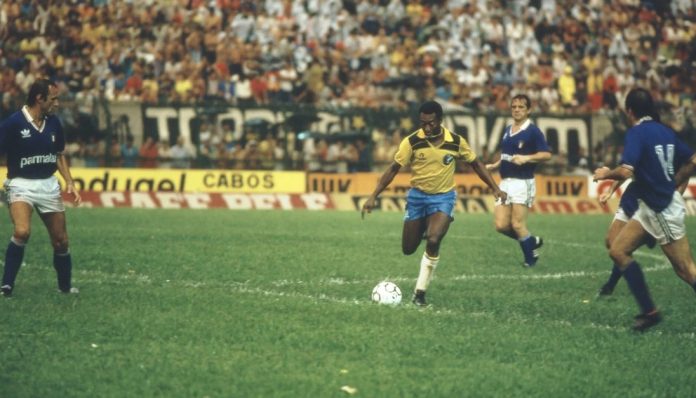The Pelé Cup, the precursor to the Over-35s World Cup, which never took place, was one of the best things modern football had, apart from renowned international tournaments such as the FIFA World Cup, UEFA Euro, UEFA Champions League, Copa Libertadores de América, and similar.
Created by the legendary Brazilian sports commentator, television presenter, journalist, announcer, and entrepreneur Luciano do Valle, the World Cup of Masters (also known as the Mundial of Seniors, later the Pelé Cup; Mundialito de Seniors and Copa Pelé in Brazilian) featured Pelé himself in 1987 at the Pacaembu stadium in São Paulo and had six editions.
Why Is There No More Pelé Cup?
The news that a Veterans World Cup (officially, Over-35s World Cup) was supposed to be held in England last June filled fans with enthusiasm.
The confirmed presence of idols such as Ronaldinho, Thierry Henry, and many others, on whose clubs bettors had faith to put money at best-rated football betting sites worldwide, such as those rated at https://bookmaker-expert.com/country/nigeria/ in their time, knowing what kind of geniuses played there, prompted the announcement by the organizer, the Elite Players Group (EPG).
Unfortunately, it didn’t take place. However, the initiative wasn’t unprecedented. In the late 1980s, Brazil was the protagonist in the creation of the World Cup of Masters.
Created by the renowned Brazilian sports worker Luciano do Valle, the tournament was named the Pelé Cup following its inaugural edition in 1987 and featured “The King“ himself in a remarkable classic at Pacaembu.
With Pelé on the field, cheered by Pacaembu audience more than a decade after his retirement, Brazil easily beat Italy 3-0, with goals from Antonello Cuccureddo (own goal), Rivellino, and Dadá Maravilha. Brazil then drew 0-0 with Uruguay, and in the decisive match was defeated by the new champion Argentina 3-1.
The frustration against the Argentines didn’t diminish the enthusiasm for the championship for the Brazilians, and the tournament would be played five more times, in four different countries, with four titles for Brazil (1989, 1990, 1991, and 1995) and one for Italy (1993).
Who Was Luciano do Valle, the Creator of the Pelé Cup?
The creator of the Pelé Cup was the historic announcer and sports journalist Luciano do Valle (1947-2014).
The man responsible for popularizing sports such as volleyball, basketball, boxing, and even snooker on open TV with his “Show do Esporte“, joined other businessmen with the aim of reviving the magic of the great stars.
In one of his interviews, Do Valle explained where his motivation came from. He said that after narrating the match at the Morumbi stadium between the clubs whose names or the match result he couldn’t even remember, he went out to dinner with the guys from Bandeirantes, a Brazilian free-to-air commercial television network.
The talk was about the low level of Brazilian football. Then they started remembering the ball skills and the genius of idols like Rivellino, Jairzinho, Edu, Gérson, and Pelé, of course. From this nostalgia came the idea of paying tribute to that generation.
It Wasn’t a Promising Start
The first Pelé Cup was played in empty stadiums and incurred a loss (the players received salaries, in addition to all the help with logistics), until it was televised by Bandeirantes.
Interestingly, Do Valle wasn’t the one responsible for announcing the matches for an unusual reason: he was chosen to coach the Brazilian team.
Apart from the TV station Bandeirantes, the International Masters Football Association (IMFA) was involved in organizing the tournament, doing so after consulting with FIFA’s general secretary, Sepp Blatter.
Two years after the inaugural experience, Brazil won its first Pelé Cup title, with a 4-2 win over Uruguay in front of 17,000 fans at the Canindé stadium.
The team included players who were still active, such as Cláudio Adão, the top scorer of the campaign with six goals. Brazil had an advantage due to the average age (32 versus 36 for the Uruguayans).
Scalded by the defeat in the 1986 Pelé Cup against Argentina, Brazilians set about putting together a strong team. Result: they won five games, drew one, scored 15 goals, and conceded only three; a thrashing!
The competition lasted in this format until 1995, hosted by Austria, and a new title for the Brazilian team. Since then, several competitions with former players have been created in different modalities, always exploring the appeal of nostalgia.
Showball competitions, on reduced-sized synthetic courts, were the solution to overcome the physical limitations of former stars.
World Cup Legends at the Pelé Cup
Two FIFA regulations were modified for this tournament: teams were permitted five substitutions rather than two, and players had to be 34 years of age or older (this was disregarded at first). In group play, teams received two points for winning, one point for tying, and zero points for losing.
If there was a tie at the end of regulation time, penalty kicks would be used to decide the semifinal, third-place, and championship matches.
Legends of the game took part in the games, which in a way brought back the FIFA World Cups from earlier years.
Zico was instrumental in Brazil’s triumph in 1990, and, as previously said, Pelé started for Brazil in the 1987 tournament’s opening match.
Mario Kempes, Klaus Allofs, Gerd Müller, Karl-Heinz Rummenigge, and Horst Hrubesch were among the other players who participated in the World Cups of Masters.
Alessandro Altobelli and Paolo Rossi were declared world champions for the second time in their careers in 1993 after winning the 1982 World Cup, and there was Rivellino, the winner in 1989 and 1990 after winning the 1970 World Cup.
In 1993, Austria, which co-hosted the event with Italy, advanced to the final. Walter Schachner, Hans Krankl, and Herbert Prohaska were among the outstanding players that the Austrians brought to the tournaments.
José Altafini, Paul Breitner, Harald Schumacher, Bruno Conti, Klaus Augenthaler, Hans-Peter Briegel, Enrico Albertosi, Jairzinho, Bobby Moore, Sócrates, René van de Kerkhof, and Frank Worthington were among the other well-known football players who participated in the competition.
The Pelé Cup Successor Ended Before It Even Started
The tournament concluded after the 1995 edition and was officially abolished by 1997, largely due to financial challenges, rising production costs, and waning TV viewership, especially outside Brazil.
Also, the concept peaked early; by the mid-90s, the novelty had worn off. There was no formal explanation from IMFA, but shifting sports media landscapes and limited commercial appeal likely sealed the Pelé Cup fate.
The new Over-35s World Cup ended even before it started. It was supposed to be contested by the eight teams that have already won the FIFA World Cup (Brazil, Germany, Italy, Argentina, France, Uruguay, Spain, and England), with seven matches played over a week in the same British stadium.
Only players who are 35 or older, who have been called up by their country, and who have played at least 100 games in a first division league were eligible to play.
However, due to a combination of factors, including a lack of social media hype, funding issues, stadium availability problems, and scheduling conflicts for the players, the Over-35s World Cup 2024 wasn’t held.



